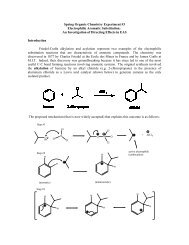A Lesson Plan for The Visually Impaired
A Lesson Plan for The Visually Impaired
A Lesson Plan for The Visually Impaired
- No tags were found...
You also want an ePaper? Increase the reach of your titles
YUMPU automatically turns print PDFs into web optimized ePapers that Google loves.
Vision impairment 1Artifact #2A <strong>Lesson</strong> <strong>Plan</strong> <strong>for</strong> <strong>The</strong> <strong>Visually</strong> <strong>Impaired</strong>In the summer of my junior year, as a pre-student teacher in the Nazareth College Inclusive ElementaryEducation Program, I developed a lesson plan that would incorporate visually impaired students. Thislesson plan was to show my understanding of including students with visual impairments, as well as showmy knowledge of the basic elements of a useful lesson plan.As I designed the lesson and the activity that supported it, I thought about how important it is <strong>for</strong> allstudents to have a hands-on experience as advocated by the constructivist approach to learning and howlanguage (reading and writing) is the primary <strong>for</strong>m of interaction as advocated by Vygotsky. I also referredto Gardner’s multiple intelligences when I created the activity <strong>for</strong> the lesson.As I learned about Danielson’s Components of Professional Practice, I realized how this lesson, and itsactivity, showed I was learning how to “Demonstrate knowledge of resources, design coherent instruction,and establish a culture <strong>for</strong> learning. Also, my expectation in creating this lesson was that I would be able to“Engage students in learning and grow and develop professionally.”I think what I learned most <strong>for</strong>m the creation of the lesson was the need to produce and supply all mylessons to meet all the needs of the students in my classroom. Also, each lesson that is taught should beengaging as well and in<strong>for</strong>mative.
Vision impairment 3· Use lager print <strong>for</strong> directions and reading· Hand out Braille worksheets· Use textbook on cassettes· Teacher will read the questions out loud to the class first and then beavailable to help students when they need help.Materials Needed:· Measuring cups· Chex mix cereal· Teddy bear graham snacks· Honey-roasted peanuts· Raisins· Candy-coated chocolate (M & M)· Plastic storage bags· Recipe· English textbook· Braille directionsLESSON OPENINGAnticipatory Set:Have the students sitting at their desk and Say- "Can you tell me how you get ready <strong>for</strong>school in the morning? (Give time <strong>for</strong> at least 2 or 3 students to answer the question).Can any of you tell me what that type of ordering is called? (Give time <strong>for</strong> at least 2 or 3students to answer the question).LESSON BODY1. Have students explain what they do in the morning to get ready <strong>for</strong> school.a) If students can tell the class what they do step by step, then go on tonumber 2.b) If students are lost, explain that you wanted them to tell you step by stepby modeling <strong>for</strong> the students.c. For students who seem to already know about chronological ordering (byanswering the question correctly with our hesitation) then they will be allowed to move<strong>for</strong>ward to the ingredients part of the lesson and write a one page paper on how to makechex party mix. If they finish that be<strong>for</strong>e the class is ready to start that then they will bepartnered up with a student who may be having trouble with the concept of chronologicalordering.2. Hand out English textbook and have them open to pg 98.3. Ask <strong>for</strong> volunteers to read the text to the class [guided practice].4. Have 2 or 3 students recap in their own words what they just read[check <strong>for</strong> understanding].5. Ask students where Chronological Ordering is used in everyday lifea) If a student says recipe then go on to step 6.b) If recipe is not said model how a recipe is an example of ChronologicalOrdering.
Vision impairment 46. Hand out recipe to students.7. Have volunteers to read the recipe out loud8. Model to the students how you are going to make the Chex Mix usingChronological Ordering.9. Model how to write in chronological ordering in a paragraph using steps orprocedure.10. Teacher will read example of tying shoe.11. As students are coming up to the front of the room to make their mix the otherchildren will start writing their paragraphs on how to make chex party mix.12. Students will make party mix [independent/guided practice] and create theirwriting.Closure: Be<strong>for</strong>e the students can leave the class they must put something theydo throughout their day in chronological order in order to make sure eachstudent’s understands what they were taught in class.LESSON FOLLOW-UPEvaluation:A. What did you want the students to learn?1. To learn chronological ordering and to see how it fits in everyday life.B. How will you know they have learned it?1. By being able to make the Chex mix and by their ticket outthe door exercise.LESSON RESOURCESReferences <strong>for</strong> student use:Suter, Joanne. (1995). Fearon's English Composition. (Second Edition). NewJersey: Globe Fearon Educational PublisherChex.com-Home of General Mills' Chex Cereals and the Original Chex Party Mix.(2001)References <strong>for</strong> teacher use:Suter, Joanne. (1995). Fearon's English Composition. (Second Edition). NewJersey: Globe Fearon Educational PublisherChex.com-Home of General Mills' Chex Cereals and the Original Chex Party Mix.(2001)Batshaw, Mark L., M.D. (2002). Children With Disabilities. (Fifth Edition). YorkPennsylvania: Paul H. Brooks Publishing Co., Inc.Friend, Marilyn; Bursuck, William D. (2002). Including Students With Special Needs.Boston MA: Allyn and Bacon A Person Education Company.
Vision impairment 5
















